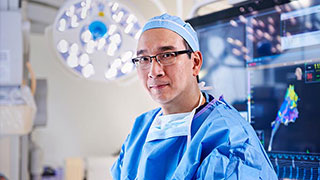Amblyopia Symptoms
In some cases there are no symptoms. For example, refractive amblyopia might be undetectable because the child does not complain of blurry vision, and the amblyopic eye might not look any different from the normal-seeing eye.
When symptoms occur, they include:
- Eyes that turn in or out (misalignment)
- Eyes that do not look at or focus on the same object
- Poor depth perception
- Poor vision in one or both eyes
Diagnosing Amblyopia
Our pediatric ophthalmology specialists can detect amblyopia with a comprehensive eye exam that includes a vision test, a sensory motor examination, and cycloplegic refraction tests with dilating eyedrops, to check refraction without the eye being able to autofocus.
A slit-lamp is used to examine the structures of the anterior portion inside the eye, and a funduscope is used to examine the posterior portion of the eye, including the retina and optic nerve.
Treatment Options for Amblyopia
At UT Southwestern, our specialists start by treating the underlying disease:
- Glasses to correct refractive error (to focus image clearly)
- Surgery to clear visual pathway obstruction, such as to remove a cataract or to correct ptosis (droopy eyelid)
- Eye muscle surgery to straighten the eyes
If the vision is not improved, doctors will start patch treatment by covering the stronger eye with a patch, to help the brain use the weaker eye and make it stronger. In some cases, we might recommend eyedrops to blur vision in the stronger eye to force the use of the weaker eye.
The number of hours per day and overall length of time that a child must wear the patch depends on the age, severity, and cause of the amblyopia. Children with severe amblyopia might need patching for more hours of the day and for months or years.
Amblyopia is not always correctable. If the condition isn’t detected early, vision might not fully respond to patching. The earlier the detection and treatment of amblyopia, the better the vision outcome. Patching usually has more success in children younger than age 8, even though recent research has shown its benefits in children up to age 17.




